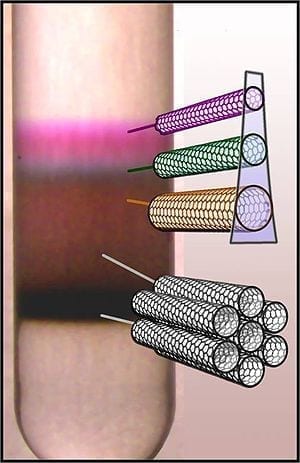
University of Illinois researchers have developed a way to heal gaps in wires too small for even the world’s tiniest soldering iron.
Led by electrical and computer engineering professor Joseph Lyding and graduate student Jae Won Do, the Illinois team published its results in the journal Nano Letters.
Carbon nanotubes are like tiny hollow wires of carbon just 1 atom thick – similar to graphene but cylindrical. Researchers have been exploring using them as transistors instead of traditional silicon, because carbon nanotubes are easier to transport onto alternate substrates, such as thin sheets of plastic, for low-cost flexible electronics or flat-panel displays.
Carbon nanotubes themselves are high-quality conductors, but creating single tubes suitable to serve as transistors is very difficult. Arrays of nanotubes are much easier to make, but the current has to hop through junctions from one nanotube to the next, slowing it down. In standard electrical wires, such junctions would be soldered, but how could the gaps be bridged on such a small scale?
“It occurred to me that these nanotube junctions will get hot when you pass current through them,” said Lyding, “kind of like faulty wiring in a home can create hot spots. In our case, we use these hot spots to trigger a local chemical reaction that deposits metal that nano-solders the junctions.”
Lyding’s group teamed with Eric Pop, an adjunct professor of electrical and computer engineering, and John Rogers, Swanlund professor in materials science and engineering, experts on carbon nanotube synthesis and transfer, as well as chemistry professor Greg Girolami. Girolami is an expert in a process that uses gases to deposit metals on a surface, called chemical vapor deposition (CVD).
The nano-soldering process is simple and self-regulating. A carbon nanotube array is placed in a chamber pumped full of the metal-containing gas molecules. When a current passes through the transistor, the junctions heat because of resistance as electrons flow from one nanotube to the next. The molecules react to the heat, depositing the metal at the hot spots and effectively “soldering” the junctions. Then the resistance drops, as well as the temperature, so the reaction stops.
The nano-soldering takes only seconds and improves the device performance by an order of magnitude – almost to the level of devices made from single nanotubes, but much easier to manufacture on a large scale.
The Latest Google Headlines on:
Nanotubes
[google_news title=”” keyword=”Nanotubes” num_posts=”10″ blurb_length=”0″ show_thumb=”left”]
The Latest Bing News on:
Nanotubes
- Dr. Gayatri Keskar, advanced materials scientist: Networking and collaboration is the key to successon May 8, 2024 at 1:03 am
Gayatri's childhood in an engineering-centric family sparked a fiery love for science and technology, which naturally guided her toward a career in engineering. She began exploring the fascinating ...
- Nanotubes, nanoparticles and antibodies detect tiny amounts of fentanylon May 2, 2024 at 1:22 pm
A research team at the University of Pittsburgh led by Alexander Star, a chemistry professor in the Kenneth P. Dietrich School of Arts and Sciences, has developed a fentanyl sensor that is six orders ...
- Nanotubes, nanoparticles, and antibodies detect tiny amounts of fentanylon May 2, 2024 at 12:43 pm
Star’s sensor uses carbon nanotubes and gold nanoparticles to tell fentanyl apart from other opioids. The key to its groundbreaking sensitivity, however, is the incorporation of fentanyl antibodies.
- Single-walled carbon nanotubes doped with 'nitrogen' enhance the performance of secondary battery anodeon April 24, 2024 at 9:27 am
Researchers have developed a new manufacturing technique for "silicon/nitrogen-doped carbon composite anode materials." These materials aim to enhance the capacity and stability of lithium-ion battery ...
- Single-walled carbon nanotubes doped with ‘nitrogen’ enhance the performance of secondary battery anodeon April 24, 2024 at 6:04 am
Development of Si alloy/nanocarbon composite anode materials that overcome the limitations of silicon using “nitrogen-doped carbon nanotubes” and “graphene” by KERI. Dr. Han Joong Tark and ...
- Carbon Nanotubes Market Size, Opportunities, Share, Growth, Regional Trends, Key Segments, Graph and Forecast to 2028on April 23, 2024 at 10:35 am
Carbon Nanotubes Market by Type (Single Walled & Multi Walled), End Use Industry (Electronics & Semiconductors, Chemical Materials & Polymers, Structural Composites, Energy & Storage, Medical), Method ...
- Scientists stencil-paint carbon nanotube components for flexible transparent electronicson April 23, 2024 at 9:23 am
Researchers from Skoltech, MIPT, and elsewhere have found a fast and inexpensive way to create geometric patterns in carbon nanotube films. The resulting films turned out to have superior properties ...
- What Is Carbon? Life's Most Crucial Element, Explainedon April 22, 2024 at 4:00 am
Carbon is found in cellulose and lignin, the structural polymers of plants, as well as the DNA they use to live, grow and reproduce. Carbon is also found in the functional proteins that let this ...
- Can we increase the safety of carbon nanotubes?on March 13, 2024 at 7:15 am
Carbon nanotubes, nano-size cylinders made of carbon atoms, are attracting renewed interest for their role in the future of cars. Industry reports project that the global market for these ...
- The Coming Copper Shortage: Aluminium Or Carbon Nanotubes To The Rescue?on September 30, 2021 at 12:06 am
Carbon-based structures, such as carbon nanotubes (CNTs) have much higher electrical conductivity than copper, as does graphene. The main issue is that making wires out of them is not exactly ...
The Latest Google Headlines on:
Carbon nanotubes
[google_news title=”” keyword=”carbon nanotubes” num_posts=”10″ blurb_length=”0″ show_thumb=”left”]
The Latest Bing News on:
Carbon nanotubes
- Dr. Gayatri Keskar, advanced materials scientist: Networking and collaboration is the key to successon May 8, 2024 at 1:03 am
Gayatri's childhood in an engineering-centric family sparked a fiery love for science and technology, which naturally guided her toward a career in engineering. She began exploring the fascinating ...
- A leap toward carbon neutrality: New catalyst converts carbon dioxide to methanolon May 6, 2024 at 8:59 am
Researchers at the University of Michigan have developed a catalyst material known as cobalt phthalocyanine that converts carbon dioxide—a significant driver of climate change—into renewable fuels ...
- Nanotubes, nanoparticles and antibodies detect tiny amounts of fentanylon May 2, 2024 at 1:22 pm
A research team at the University of Pittsburgh led by Alexander Star, a chemistry professor in the Kenneth P. Dietrich School of Arts and Sciences, has developed a fentanyl sensor that is six orders ...
- Single-walled carbon nanotubes doped with 'nitrogen' enhance the performance of secondary battery anodeon April 24, 2024 at 9:27 am
Researchers have developed a new manufacturing technique for "silicon/nitrogen-doped carbon composite anode materials." These materials aim to enhance the capacity and stability of lithium-ion battery ...
- Single-walled carbon nanotubes doped with ‘nitrogen’ enhance the performance of secondary battery anodeon April 24, 2024 at 6:04 am
Development of Si alloy/nanocarbon composite anode materials that overcome the limitations of silicon using “nitrogen-doped carbon nanotubes” and “graphene” by KERI. Dr. Han Joong Tark and ...
- Carbon Nanotubes Market Size, Opportunities, Share, Growth, Regional Trends, Key Segments, Graph and Forecast to 2028on April 23, 2024 at 10:35 am
Carbon Nanotubes Market by Type (Single Walled & Multi Walled), End Use Industry (Electronics & Semiconductors, Chemical Materials & Polymers, Structural Composites, Energy & Storage, Medical), Method ...
- Scientists stencil-paint carbon nanotube components for flexible transparent electronicson April 23, 2024 at 9:23 am
Researchers from Skoltech, MIPT, and elsewhere have found a fast and inexpensive way to create geometric patterns in carbon nanotube films. The resulting films turned out to have superior properties ...
- How to ensure readiness of next-generation defense technology: Solving the issue of massive heat.on April 22, 2024 at 7:33 am
High-performance systems generate tremendous amounts of heat that can compromise missions and make high-tech systems less effective in tactical environments. But there is a solution to this modern-age ...
- What Is Carbon? Life's Most Crucial Element, Explainedon April 22, 2024 at 4:00 am
Carbon is found in cellulose and lignin, the structural polymers of plants, as well as the DNA they use to live, grow and reproduce. Carbon is also found in the functional proteins that let this ...
- SiAT Partners with Zeon to Launch Innovative SWCNT Conductive Paste, Enhancing Battery Fast Charging and Energy Densityon April 17, 2024 at 8:00 pm
This collaboration marks the introduction of single-walled carbon nanotube conductive paste. The product can replace or be combined with carbon black to serve as a conductive agent additive in Lithium ...










